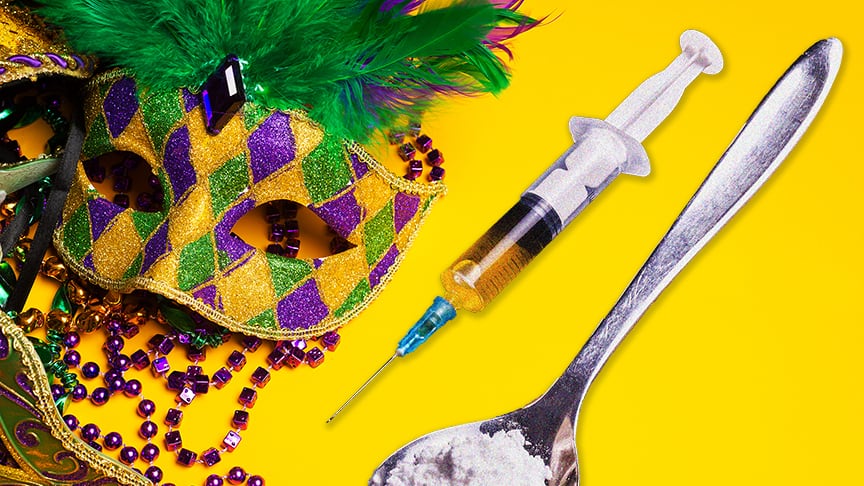“It’s killing people. It is dropping them left and right,” says New Orleans paramedic Brooke Christy.
Christy walked into a truck stop bathroom two weeks ago to find a 30-something woman having a heroin overdose.
The woman was playing in the truck stop’s casino when she took a break to shoot up in the restroom. Minutes later, she was thrown back into consciousness, with medics looming over her and a reversal agent coursing through her veins.
Though she had track marks—scars and bruises—on her arm, and she’d nearly stopped breathing and turned blue, this was one of the lucky ones.
In a few weeks’ time, at least seven opioid users died of overdoses before they even reached the doors of a hospital, based on preliminary findings from the city coroner’s office.
City of New Orleans Coroner Jeffrey C. Rouse called a recent uptick in heroin overdoses—from Jan. 8 to Jan. 29—“a public health crisis” likely caused by dealers lacing the drug with fentanyl, a synthetic opioid.
With Mardi Gras season quickly approaching, City Medical Director Joseph Kanter issued an order last week, announcing that the most common reversal agent—naloxone—would now be available over-the-counter without a prescription.
Louisiana already allowed physicians to prescribe naloxone, also known as Narcan, to anyone who requests it without examination, enabling friends and family members of heroin users to easily acquire the drug.
New Orleans EMS, which reportedly responds to roughly two heroin overdoses per day, is now responding to about five, city spokesperson Hayne Rainey says. In January 2015, a total of 110 Narcan dosages were used to treat 78 patients. By comparison, last month, 197 Narcan doses were used on 119 patients. Christy says that one day last month, her coworkers responded to 11 heroin-related overdose calls.
“Data is still being collected from local hospitals to determine the total number of overdoses,” Rainey says. But at least one hospital, University Medical Center, reported a marked increase. Over a two-day period in January, the emergency room had 14 people admitted on heroin overdoses. The hospital’s chief medical officer, Peter DeBlieux, says, “Having one to two patients a day would be normal.”
“We see probably close to 30 per month… If I’m seeing half of that in two days, that’s a pretty big deal.” DeBlieux continues, “That’s just the tip of the iceberg. There may be a number of patients who were near death or completely unconscious who recovered all on their own.”
Signs of an opiate overdose include decreased consciousness, lethargy, sluggishness, shallow breathing, and small pupils, Christy said.
Back in that truck stop bathroom, Christy was working to convince her patient that the heroin circulating in the city right now is not what heroin abusers are used to.
“This isn’t the stuff that you did six months ago,” Christy remembers telling her. “This is a totally different monster.”
She adds, “It gets every walk of life. You pick them up in every part of town. You pick them up homeless, rich, everything. The drugs get everybody.”
“It broke my heart because she’s a mom, she’s got a young kid, and she’s going through a divorce,” Christy says. “She was really sweet and really apologetic.”
A statement from the city’s coroner’s office said officials are confident that the problem is a result of a fentanyl influx, though no one has said they are clear on why.
Rouse says, “Not only is fentanyl over 10 times as potent [as heroin], it is approximately 10 times cheaper to produce. Thus, illicit drug suppliers have begun to introduce it into the Greater New Orleans market, sometimes mixing it.”
“The likely re-emergence of fentanyl on the streets is particularly alarming,” Rouse says, since users can’t tell when it’s been added. “They can die so quickly that antidotes may be too late.”
Rouse said the Orleans Parish Coroner’s office recorded 44 accidental heroin-overdose deaths in 2014, and 43 deaths the following year. Those numbers make the at least seven deaths in January even more staggering in comparison.
While DeBlieux says officials have seen this problem before, the last time it had such drastic numbers was in the late 1980s, when more potent batches of the drug were making their way into the states through different supply chains. It’s been decades since the New Orleans heroin supply has been so lethal.
But, importantly, the issue—though bigger in scale in New Orleans over the past several weeks—is not unique to the city.
DeBlieux says, “It’s the same thing across the country. People are lacing heroin with fentanyl all over, and anybody who is a consistent user of opiates should have Narcan on board and their family should be educated in how to use it.”
In December 2015, the Centers for Disease Control announced that data shows a six-fold increase in heroin-related deaths between 2001 and 2014, rising from fewer than 2,000 annual deaths nationwide to nearly 12,000.
The National Institute of Health reports that more than 2.5 million Americans abuse opioids.






